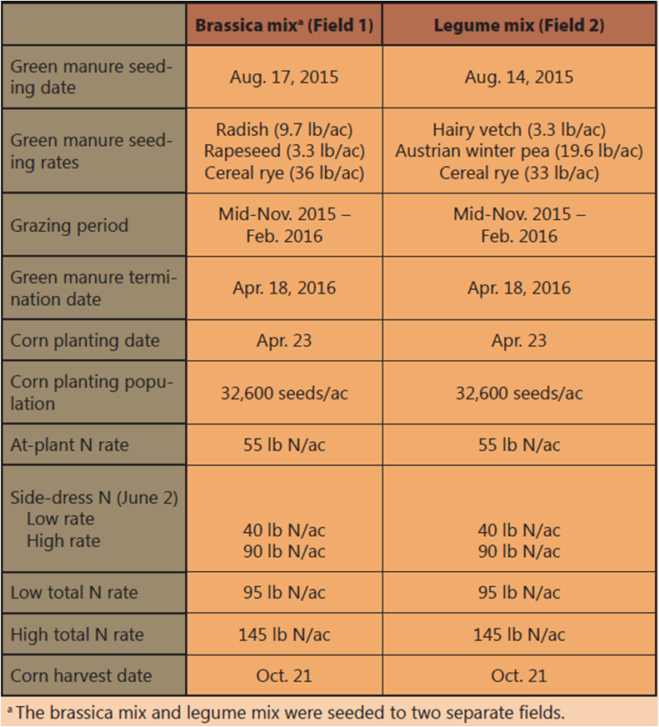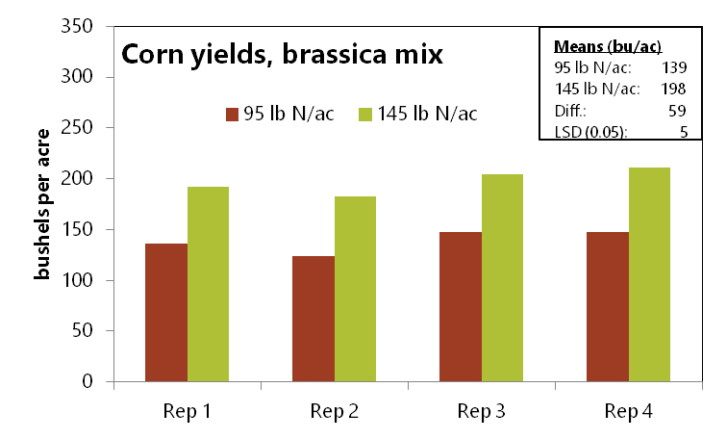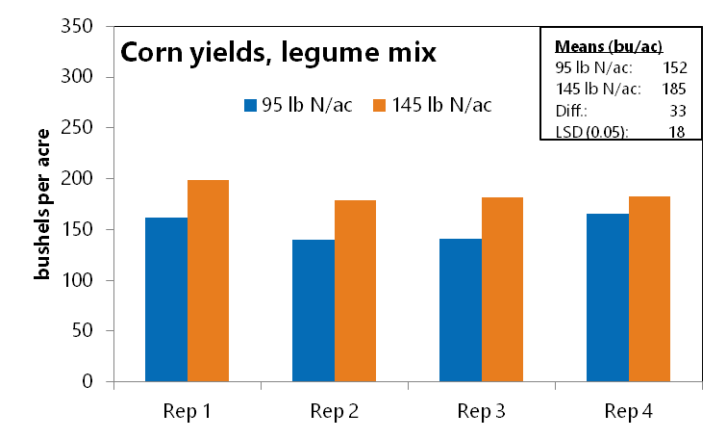RESEARCH REPORT: N Rate Comparison in Corn Following Green Manure Cover Crop Mixes
Various green manure cover crop mixes can successfully be established following the harvest of a small grain crop in mid-summer. Following cereal rye seed harvest in July 2015, farmer-cooperator Tim Sieren seeded a brassica mix into one field and a legume mix into another field. He then compared 2016 corn yields resulting from a Low and High N fertilizer rate that followed the green manure mixes in the separate fields. Previously, Tim compared N rates to corn in 2014 following a red clover green manure that he established with a cereal rye seed crop in July 2013: N Replacement Value of Red Clover.
The objective of this present on-farm research trial was to quantify the agronomic and economic effect on corn yields receiving a Low and High nitrogen fertilizer rate following two different green manure cover crop mixes seeded after cereal rye harvest. In designing the trial, Sieren says, “I hope to gain experience and confidence when cutting nitrogen rates for corn following legume and brassica cover crop mixes.”
You can read the full report here: Nitrogen Rate Comparison in Corn Following Green Manure Cover Crop Mixes.
The table below outlines how Tim conducted the trials in each field.

Key Findings:
- Regardless of the green manure mix it followed, corn yields were significantly greater with the 145 lb N/ac (High) rate compared to the 95 lb N/ac (Low) rate (figures for each field below).

Corn yields from each Rep as affected by N rate in the field that had the brassica green manure mix (radish-rapeseed-cereal rye). Mean yields and the least significant difference (LSD) at the P ≤ 0.05 level are indicated in the inset table. Because the difference between the two treatment means is greater than the LSD, the treatments are considered significantly different.

Corn yields from each Rep as affected by N rate in the field that had the legume green manure mix (hairy vetch-Austrian winter pea-cereal rye). Mean yields and the least significant difference (LSD) at the P ≤ 0.05 level are indicated in the inset table. Because the difference between the two treatment means is greater than the LSD, the treatments are considered significantly different.
- At a nitrogen fertilizer cost of $0.40 per lb N, the 145 lb N/ac total rate cost an additional $20/ac compared to the 95 lb N/ac total rate. Considering only the difference in N fertilizer cost and corn grain returns with a price of $3.42/bu on Nov. 10, corn yields from the 145 lb N/ac rate netted an additional $181.78/ac in the field with the brassica mix and netted an additional $96.16/ac in the field with the legume mix.
“I usually plan for 190 lb N/ac to grow 200 bu/ac corn.” Sieren says. “I generally credit 40 lb N/ac from soybeans, and about 75 lb N/ac from pit manure, so that leaves 75 lb N/ac left to split between planting and side-dress fertilizer applications. I didn’t have beans or manure on the research plots in this trial, so used 145 lb N/ac and planned on the 40-50 lb N/ac from the green manure cover crop mixes. Probably would’ve been enough, if July and August wouldn’t have been so wet.
“In the future, I plan to use different combinations of these mixes to optimize soil biology, and utilize them as a forage source for cows in the fall grazing season, and not as much as a nitrogen source for corn.”
For more details on this project, read the full report here: Nitrogen Rate Comparison in Corn Following Green Manure Cover Crop Mixes. This project is supported by the Walton Family Foundation.
For more information about this study and other studies as part of PFI’s Cooperators’ Program, contact Stefan Gailans at stefan@practicalfarmers.org.

